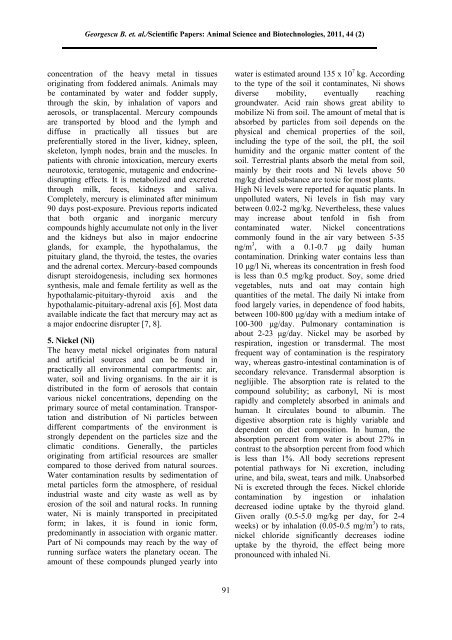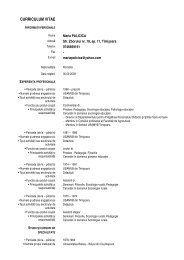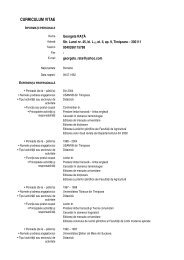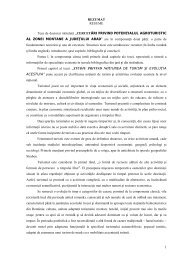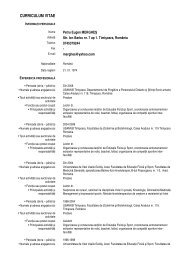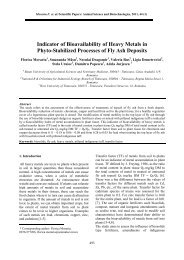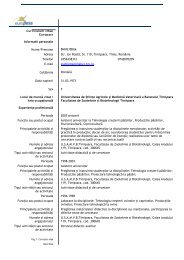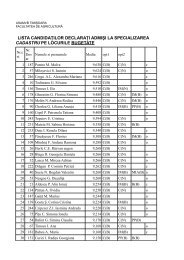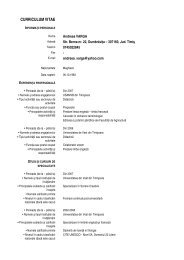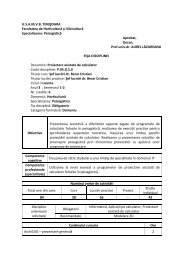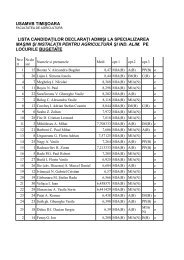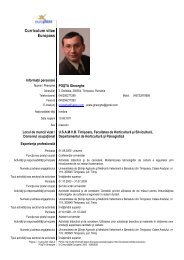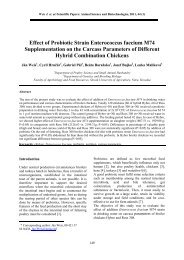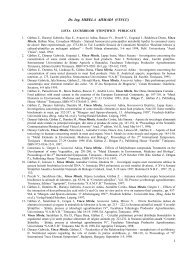Heavy Metals Acting as Endocrine Disrupters
Heavy Metals Acting as Endocrine Disrupters
Heavy Metals Acting as Endocrine Disrupters
You also want an ePaper? Increase the reach of your titles
YUMPU automatically turns print PDFs into web optimized ePapers that Google loves.
Georgescu B. et. al./Scientific Papers: Animal Science and Biotechnologies, 2011, 44 (2)concentration of the heavy metal in tissuesoriginating from foddered animals. Animals maybe contaminated by water and fodder supply,through the skin, by inhalation of vapors andaerosols, or transplacental. Mercury compoundsare transported by blood and the lymph anddiffuse in practically all tissues but arepreferentially stored in the liver, kidney, spleen,skeleton, lymph nodes, brain and the muscles. Inpatients with chronic intoxication, mercury exertsneurotoxic, teratogenic, mutagenic and endocrinedisruptingeffects. It is metabolized and excretedthrough milk, feces, kidneys and saliva.Completely, mercury is eliminated after minimum90 days post-exposure. Previous reports indicatedthat both organic and inorganic mercurycompounds highly accumulate not only in the liverand the kidneys but also in major endocrineglands, for example, the hypothalamus, thepituitary gland, the thyroid, the testes, the ovariesand the adrenal cortex. Mercury-b<strong>as</strong>ed compoundsdisrupt steroidogenesis, including sex hormonessynthesis, male and female fertility <strong>as</strong> well <strong>as</strong> thehypothalamic-pituitary-thyroid axis and thehypothalamic-pituitary-adrenal axis [6]. Most dataavailable indicate the fact that mercury may act <strong>as</strong>a major endocrine disrupter [7, 8].5. Nickel (Ni)The heavy metal nickel originates from naturaland artificial sources and can be found inpractically all environmental compartments: air,water, soil and living organisms. In the air it isdistributed in the form of aerosols that containvarious nickel concentrations, depending on theprimary source of metal contamination. Transportationand distribution of Ni particles betweendifferent compartments of the environment isstrongly dependent on the particles size and theclimatic conditions. Generally, the particlesoriginating from artificial resources are smallercompared to those derived from natural sources.Water contamination results by sedimentation ofmetal particles form the atmosphere, of residualindustrial w<strong>as</strong>te and city w<strong>as</strong>te <strong>as</strong> well <strong>as</strong> byerosion of the soil and natural rocks. In runningwater, Ni is mainly transported in precipitatedform; in lakes, it is found in ionic form,predominantly in <strong>as</strong>sociation with organic matter.Part of Ni compounds may reach by the way ofrunning surface waters the planetary ocean. Theamount of these compounds plunged yearly intowater is estimated around 135 x 10 7 kg. Accordingto the type of the soil it contaminates, Ni showsdiverse mobility, eventually reachinggroundwater. Acid rain shows great ability tomobilize Ni from soil. The amount of metal that isabsorbed by particles from soil depends on thephysical and chemical properties of the soil,including the type of the soil, the pH, the soilhumidity and the organic matter content of thesoil. Terrestrial plants absorb the metal from soil,mainly by their roots and Ni levels above 50mg/kg dried substance are toxic for most plants.High Ni levels were reported for aquatic plants. Inunpolluted waters, Ni levels in fish may varybetween 0.02-2 mg/kg. Nevertheless, these valuesmay incre<strong>as</strong>e about tenfold in fish fromcontaminated water. Nickel concentrationscommonly found in the air vary between 5-35ng/m 3 , with a 0.1-0.7 μg daily humancontamination. Drinking water contains less than10 μg/l Ni, where<strong>as</strong> its concentration in fresh foodis less than 0.5 mg/kg product. Soy, some driedvegetables, nuts and oat may contain highquantities of the metal. The daily Ni intake fromfood largely varies, in dependence of food habits,between 100-800 μg/day with a medium intake of100-300 μg/day. Pulmonary contamination isabout 2-23 μg/day. Nickel may be <strong>as</strong>orbed byrespiration, ingestion or transdermal. The mostfrequent way of contamination is the respiratoryway, where<strong>as</strong> g<strong>as</strong>tro-intestinal contamination is ofsecondary relevance. Transdermal absorption isneglijible. The absorption rate is related to thecompound solubility; <strong>as</strong> carbonyl, Ni is mostrapidly and completely absorbed in animals andhuman. It circulates bound to albumin. Thedigestive absorption rate is highly variable anddependent on diet composition. In human, theabsorption percent from water is about 27% incontr<strong>as</strong>t to the absorption percent from food whichis less than 1%. All body secretions representpotential pathways for Ni excretion, includingurine, and bila, sweat, tears and milk. UnabsorbedNi is excreted through the feces. Nickel chloridecontamination by ingestion or inhalationdecre<strong>as</strong>ed iodine uptake by the thyroid gland.Given orally (0.5-5.0 mg/kg per day, for 2-4weeks) or by inhalation (0.05-0.5 mg/m 3 ) to rats,nickel chloride significantly decre<strong>as</strong>es iodineuptake by the thyroid, the effect being morepronounced with inhaled Ni.91


